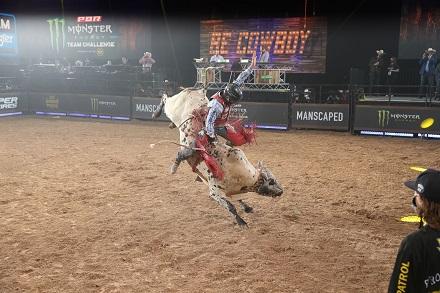
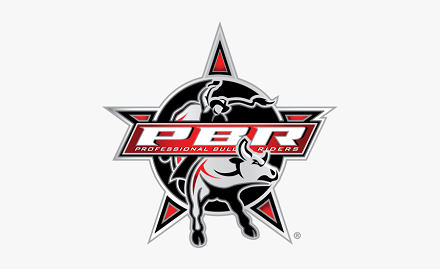 Sports Destination Management: PBR has been hosting live events almost since the beginning of the pandemic. What was the a-ha moment when you realized you were in a good position to move forward with this?
Sports Destination Management: PBR has been hosting live events almost since the beginning of the pandemic. What was the a-ha moment when you realized you were in a good position to move forward with this?
Andrew Giangola: In mid March, PBR was the last major professional sport to hold an event in Duluth, Georgia when the first restriction on mass gatherings was announced due to COVID-19. We had to alert fans that they unfortunately couldn’t attend the event, and we held it with a small crew for television-only. Immediately following the event, the restrictions on gatherings were increased. Frankly, at that time we didn’t know what kind of position we were in. This was all so new. But one thing we did know is PBR wasn’t going to sit around and wait for instructions for getting back to competition in unforeseen, unpredicted, unprecedented circumstances. The planning for our comeback literally began as our team drove to the Atlanta airport and boarded planes. The can-do cowboy spirt was special to watch and participate in. Over the ensuing days and weeks, it was less of being one ‘ah-ha moment,’ and more a lot of moments when you realize, ‘we can do this.’ Of course, that’s just when you’re confronted with the next new hurdle and call another Zoom to put heads together for figuring out a solution.
SDM: What precautions did you take, in creating the “new and improved” (for lack of better terminology) PBR?
Giangola:The safety of fans and competitors is always PBR’s top priority. During the onset of COVID-19, that overriding objective was the lens for addressing many unknowns and fresh challenges confronting the team on a daily, sometimes hourly basis.
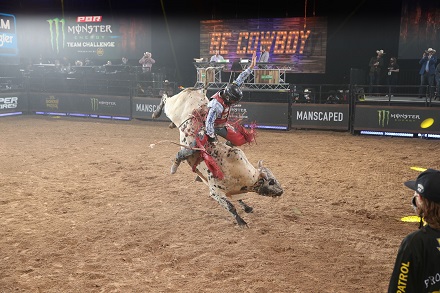
PBR then created a comprehensive plan of new protocols to help ensure the safety of everyone present at the event as well as the surrounding community. The protocols include medical testing for any participant in the event (bull riders, stock contractors and crew) before they travel to an event market, strict adherence to mask usage and social distancing, and rigorous sanitization of equipment and touch-points.
An event during a pandemic is like flying an airplane – every protocol and safety element is crucial. One link in the chain breaks, and you can crash. Perhaps the most critical element for PBR’s return has been requiring COVID testing for anyone to come to an event market. This helps ensure the sport is not bringing the virus into the event or spreading it unknowingly into the community.
Once PBR began welcoming fans into the arena in July, another part of the plan worth highlighting is to separate people as much as possible, including the introduction of Pod Seating for all fans to distance them in the stands. We have been selling only up to 50% of the arena capacity to distance fans who are enjoying the bull riding action.
PBR also emphasizes cashless transactions and mobile ticketing for fewer interactions at the box office window. We have eliminated some sponsor activations and other activities on the concourse to create more space among fans. Merchandise sales at the arena are now limited to the top-selling items to make for faster decisions and fewer lines. While each market may be a bit different, we are strongly recommending measures like these to our arena partners who share our goal of having a safe event.
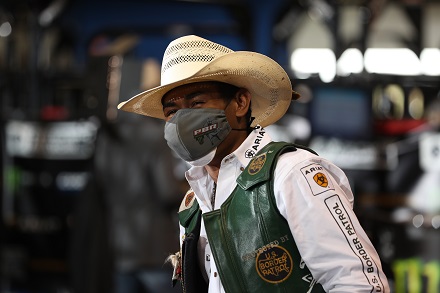 And in all markets, we are following and will continue to follow government guidance in working with arena partners to hold safe and responsible events.
And in all markets, we are following and will continue to follow government guidance in working with arena partners to hold safe and responsible events.
By adhering to our protocols PBR has been able to return safely to competition, starting in Oklahoma in late April with a closed televised events. In mid-July, PBR added fan guidelines to the plan and in Sioux Falls, South Dakota, became the first pro sport to welcome fans back into the arena, albeit only selling a maximum of half the available seats.
SDM: What was the reception like from the venues?
Giangola: Venues are obviously very dependent on live ticketed events. They want to get back to business. They’ve been extremely receptive of our protocols and eager to collaborate on events. We have always enjoyed strong venue partnerships, and during COVID-19, our relationships have gotten stronger. Times of crisis are difficult. But they can also bring resilient people together.
SDM: Have the fans been happy with the events produced?
Giangola: PBR may not have the biggest fan base in sports, but it’s hard to imagine a more loyal fan base. (A recent study shows PBR has the most fan engagement on social media among major sports.) Fans are thrilled to be able to attend events again. They also take a lot of pride that their favorite sport was the first to return to competition.
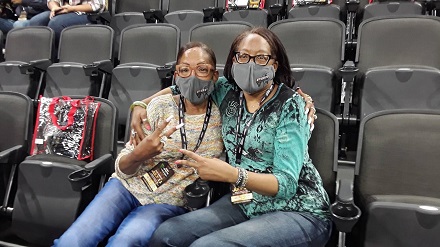 I interviewed a few fans after the Sioux Falls event. Evelyn Robinson and her sister Cynthia Johnson (shown on right) from San Jose are avid PBR fans who travel to a half dozen events each season. The sisters decided when fans were allowed back in the arena, they’d definitely be there cheering on their favorite cowboys and bulls.
I interviewed a few fans after the Sioux Falls event. Evelyn Robinson and her sister Cynthia Johnson (shown on right) from San Jose are avid PBR fans who travel to a half dozen events each season. The sisters decided when fans were allowed back in the arena, they’d definitely be there cheering on their favorite cowboys and bulls.
“We were not at all nervous,” Evelyn told me after the Sioux Falls event. “I felt really confident with PBR’s safety measures. There was constant spraying and wiping, and people were wearing masks. We felt completely safe and comfortable and decided to go to the next two PBR events in Bismarck and Billings.”
SDM: What has the TV viewership been like?
Giangola:Very strong. In fact, on Sunday Sept 13, a very busy day in sports, PBR was the No. 2-rated sport on TV, trailing only the NFL. More fans watched PBR than the NBA and NHL playoffs, PGA Golf, Major League Baseball, and all other sports in action. It’s a great testament to just how exciting this sport is, and the loyalty of our fans.
SDM: Do you feel as though, in the absence of many other sports, people have come to watch and follow PBR’s events?
Giangola: We know we picked up sampling from new fans who might not have seen PBR before. To what extent will require research. Right now, with 14 events rescheduled in the second half due to changing market-by-market conditions, the PBR team is focused on keeping the sport going, and planning the best World Finals ever at AT&T Stadium in Texas, Nov. 12-15.
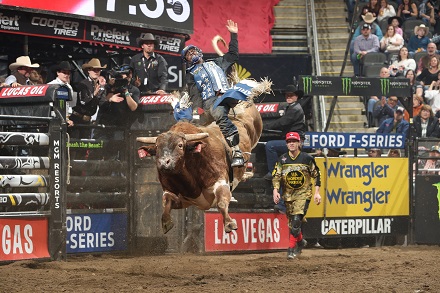 SDM: How many events has PBR been able to broadcast?
SDM: How many events has PBR been able to broadcast?
Giangola: PBR has had 37 broadcasts on CBS and CBS Sports Network since the event in Duluth in March when Coronavirus restrictions basically shut down the entire sports world.
SDM: Has COVID made the production difficult?
Giangola: Every element of the event falls under the protocols. For the TV production, we are covering events for the CBS broadcasts with approximately 20% fewer people. There are fewer manned cameras, which means that a smaller crew is working harder and doing more things, with most everyone becoming a utility player. To limit the number of crew, we are utilizing some robotic cameras and POVs. Crews have to follow PBR’s overall safety protocols – including medical testing, social distancing, wearing masks and frequent hand sanitization. The TV crew in the truck, for example, is required to wear masks, which is a challenge with a headset on, but one we need to manage during this time. Our CBS play by play announcers and color analyst are in the arena, socially distanced. Sideline interviews are done at a distance with boom mics.
SDM: Are spectators allowed at all in any of the events – or does it really depend upon where they are?
Giangola: Starting in mid-July, PBR began hosting fan indoors – becoming the first professional sport to do so. We began first at the Denny Sanford PREMIER Center, a great indoor arena, July 10-12, with new safety protocols in place for the playoffs of the new Monster Energy Team Challenge. The events were held safely, responsibly and without incident. In applying new safety protocols, we have now hosted a number of safe and successful event weekends in places like Billings, Mont.; Bismarck, S.D.; Ft. Worth, Texas; Guthrie, Okla; and Des Moines, Iowa.
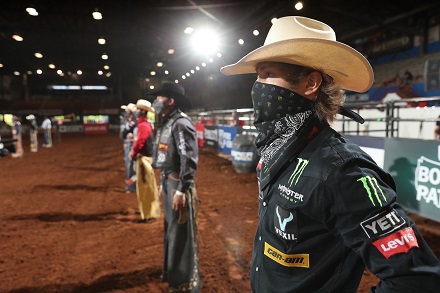 SDM: What is the best part about being able to host live events during the pandemic?
SDM: What is the best part about being able to host live events during the pandemic?
Giangola: Showing the world how it’s possible to get back to business during the pandemic safely and responsibly. And getting our cowboys back to work. So many people – bull riders who are not on guaranteed contracts, stock contractors, crews who are largely independent contractors, and other staff – rely on PBR to feed their families. To a person, I believe you’d hear this has been the biggest challenge of their professional careers. Talk to PBR athletes, and you’ll hear them say riding a bull is all about “try.” And that when you get knocked down, you get back up. We’ve tried our hearts out and have certainly been knocked down a bunch since March, but have persevered to stay the course and keep adjusting, and we’ve now held 14 event weekends successfully. It’s been rewarding to work very hard to move mountains just about every week to get back to business. Fighting through this experience, we are definitely a closer group…more admiring, patient and respectful of one another.
SDM: Any advice you’d be able to share with owners of other events?
Giangola: Safety should always be the top priority. If it isn’t, make it No. 1. Do the hard research, and the even harder planning. Be very disciplined on executing your protocols. Human nature will inevitably lead to letting your guard down – identify and resist this temptation. Observe and analyze how other teams and leagues are keeping athletes safe while hosting fans. Share your plan with government officials. As in any crisis, this is as much a communications challenge as anything else. Keep everyone – athletes, employees, venue partners, sponsors, and fans -- appropriately informed.
SDM: Anything else you’d like to add, or point out?
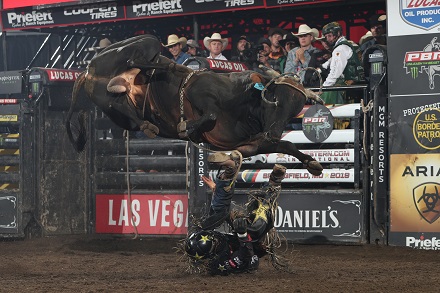 Giangola: The PBR team and our partners have done an outstanding job in PBR’s return to competition. Despite very difficult circumstances, what the PBR industry has accomplished in being the first sport back to competition and then the first to host fans is nothing short of Herculean. We’ve now had 14 successful event weekends during a pandemic. This has been a year of outstanding bull riding already with Jose Vitor Leme in particular having a season for the ages, and we’re very excited about holding World Finals at AT&T Stadium – the NFL’s largest stadium with plenty of space to spread out. We would encourage fans to come enjoy the event November 12-15 in Arlington, Texas.
Giangola: The PBR team and our partners have done an outstanding job in PBR’s return to competition. Despite very difficult circumstances, what the PBR industry has accomplished in being the first sport back to competition and then the first to host fans is nothing short of Herculean. We’ve now had 14 successful event weekends during a pandemic. This has been a year of outstanding bull riding already with Jose Vitor Leme in particular having a season for the ages, and we’re very excited about holding World Finals at AT&T Stadium – the NFL’s largest stadium with plenty of space to spread out. We would encourage fans to come enjoy the event November 12-15 in Arlington, Texas.
SDM: How does PBR select locations for its events? (Whether in COVID time or in regular time)?
Giangola: A number of factors are weighed in selecting the location of PBR events, including geographic diversity (allowing us to bring events to all corners of the country); places where we can expose our sport to new fans while also serving core fans; having our events in top-tier facilities that host elite pro sports; and having strong support from local partners.
During Coronavirus, we now factor in changing conditions around the country alongside local and state COVID-19 guidelines, which we always adhere to. From a community perspective, we want go where there is understanding and acknowledgement of our stringent protocols for holding safe and responsible events and therefore, PBR is welcomed.
SDM: And in December, you're going to be presenting PBR Air Force Reserve Cowboys for a Cause aboard the USS Lexington to benefit Operation Homefront. It sounds like it's going to be great.
Giangola: That event is going to be epic.

